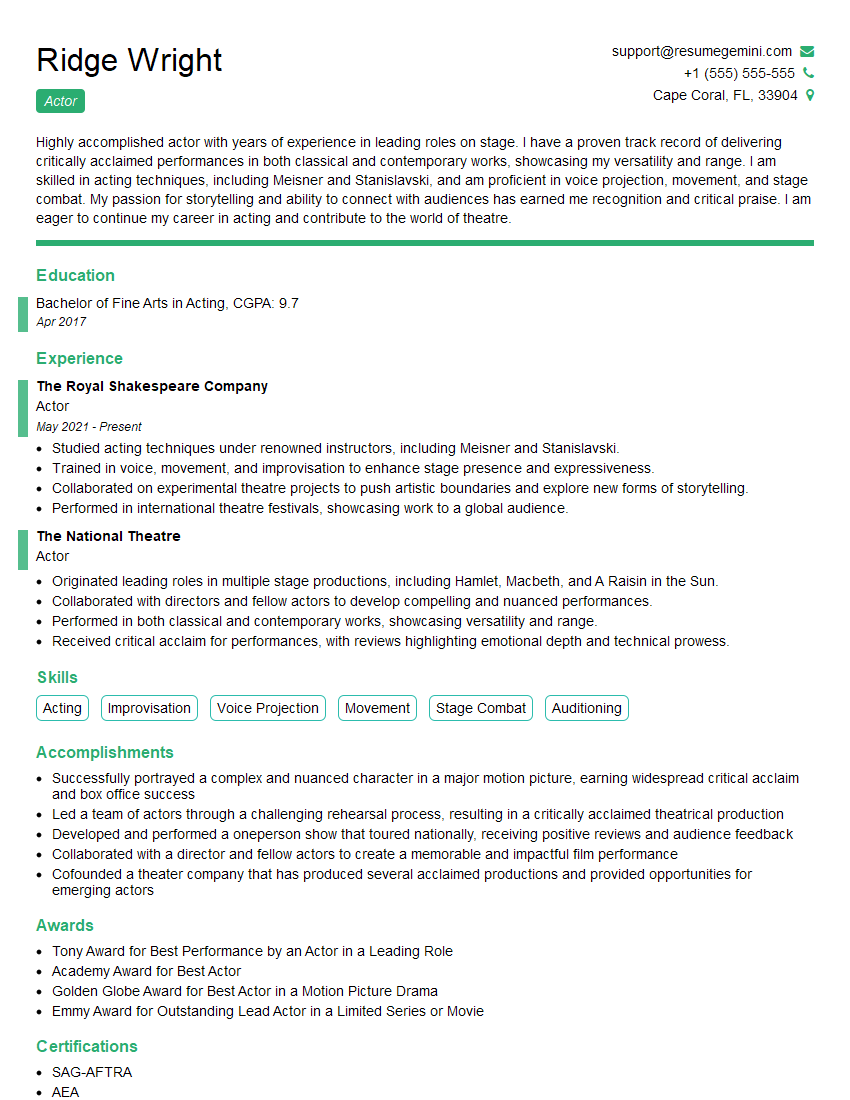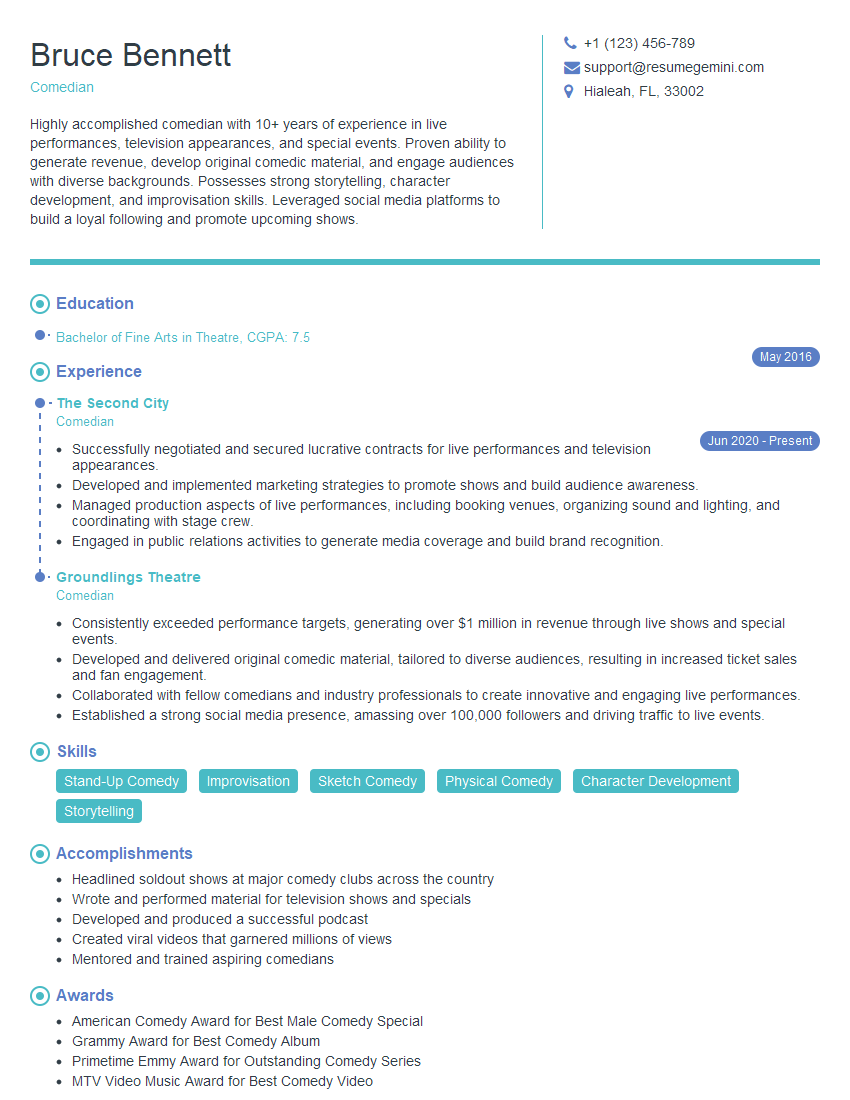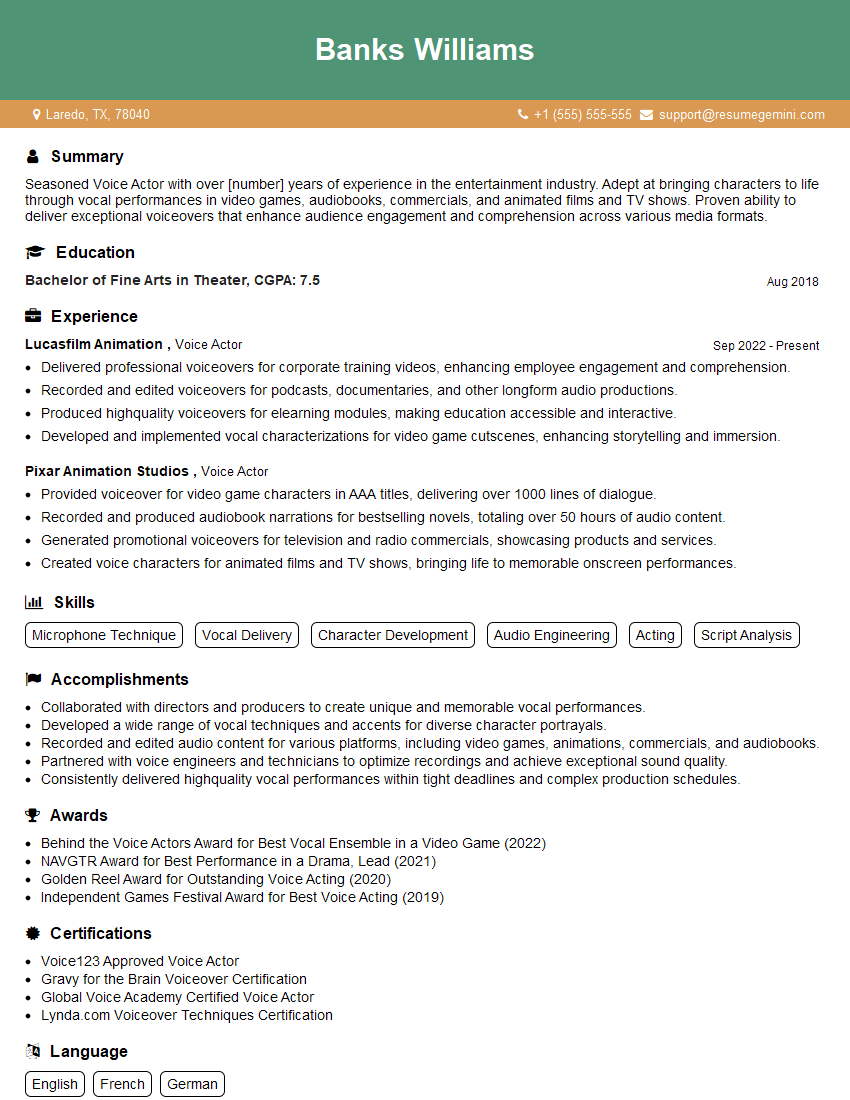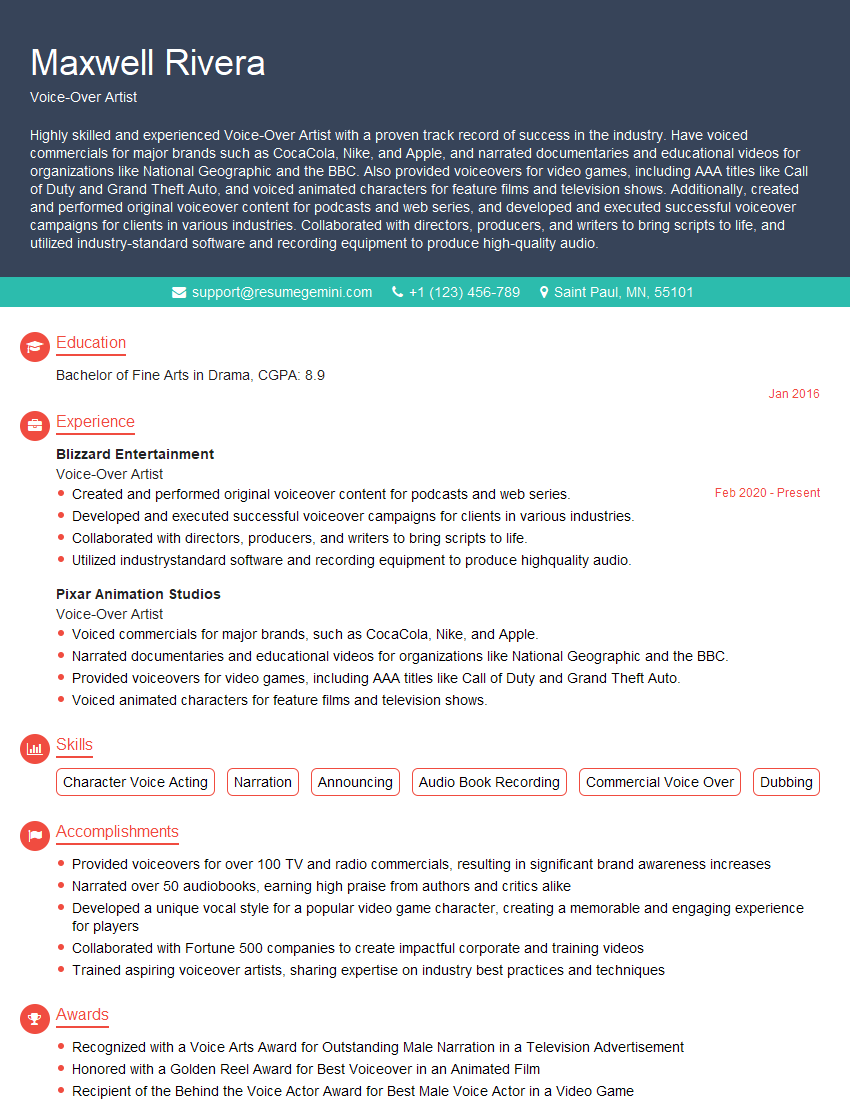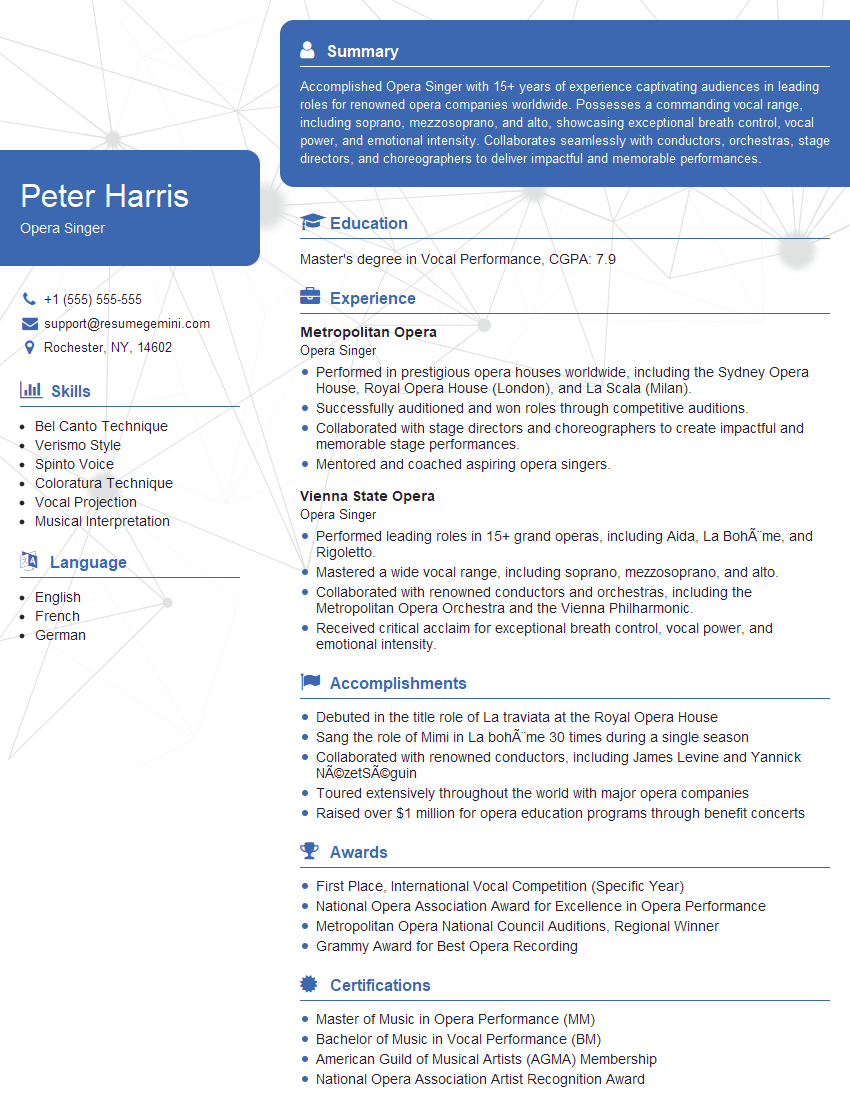Warning: search_filter(): Argument #2 ($wp_query) must be passed by reference, value given in /home/u951807797/domains/techskills.interviewgemini.com/public_html/wp-includes/class-wp-hook.php on line 324
The right preparation can turn an interview into an opportunity to showcase your expertise. This guide to Dramatic Acting interview questions is your ultimate resource, providing key insights and tips to help you ace your responses and stand out as a top candidate.
Questions Asked in Dramatic Acting Interview
Q 1. Explain your approach to analyzing a dramatic script.
My approach to analyzing a dramatic script is multifaceted and iterative. It begins with a deep read, focusing not just on the dialogue but on subtext, the unspoken motivations and emotions driving each character. I then create a detailed character breakdown, identifying their objectives, obstacles, and relationships with other characters. This involves exploring their backstory, examining their relationships, and analyzing their arc throughout the play. I look for the key moments of transformation and ask myself: What is this character’s central conflict? What do they want, and what is stopping them from achieving it? Finally, I analyze the overall structure of the play, understanding how my character fits into the larger narrative and contributes to the overall theme.
For instance, in analyzing Hamlet, I wouldn’t just focus on Hamlet’s famous soliloquies but also on the nuances of his interactions with Gertrude, Claudius, and Ophelia. Understanding their relationships, and the power dynamics between them, is crucial in crafting a believable portrayal of Hamlet.
Q 2. Describe your process for developing a believable character.
Developing a believable character is a journey of discovery, not just imitation. It starts with understanding the script’s demands and then filling in the gaps with my own creative process. I begin with the text, identifying the character’s stated traits and actions. Then, I move beyond the page, creating a rich backstory – where did they grow up? What are their hopes and fears? What are their defining experiences? I develop a physicality that matches their personality – posture, gait, gestures. I also consider their relationships: how do they interact with others? How do their relationships affect their behavior? Finally, I work on finding the emotional truth behind their actions. What are the unspoken motivations driving their choices? Imagine playing Lady Macbeth: I wouldn’t just focus on her ambition; I’d delve into her insecurities, vulnerabilities, and the price of her ambition.
Q 3. How do you utilize physicality to enhance your dramatic performance?
Physicality is the unspoken language of acting. It’s not just about gestures; it’s about posture, gait, the way a character uses space. Every movement should be deliberate and motivated by the character’s inner life. For example, a character consumed by grief might have slumped shoulders and a slow, hesitant gait, while a confident character might stand tall with a purposeful stride. I use movement exercises, like Alexander Technique or Viewpoints, to develop a deeper understanding of my body and how it can express emotion. Consider a scene where a character is lying: a nervous character might fidget, while a deceitful one might remain rigidly still. These small details, meticulously crafted, add layers of depth and believability to the performance.
Q 4. How do you incorporate vocal techniques to convey emotion effectively?
Vocal technique is paramount in conveying emotion. It’s about more than just projection; it’s about tone, rhythm, pace, and pauses. I work extensively on breath control, articulation, and vocal resonance to ensure my voice can effectively communicate the character’s emotional state. A character’s voice should reflect their personality, their social status, and their emotional journey. For instance, a character overwhelmed by fear might speak in a trembling voice, whereas a character brimming with confidence might use a resonant, assertive tone. I regularly practice vocal exercises, including scales, tongue twisters, and improvisational vocal work, to expand my vocal range and control.
Q 5. What techniques do you use to manage stage fright or on-camera nerves?
Stage fright and on-camera nerves are common challenges. My strategy involves thorough preparation – knowing the script inside and out, understanding the character intimately, and rehearsing extensively. I also employ relaxation techniques, such as deep breathing and mindfulness, to calm my nerves before a performance. Visualizing a successful performance, focusing on the connection with the audience or camera, and remembering my passion for the craft all help to reduce anxiety. Building a strong foundation of confidence through rigorous training and experience is also key to managing these challenges. In essence, preparation and mindful self-regulation are my key tools.
Q 6. How do you prepare for a role that requires a significant emotional range?
Preparing for a role with a significant emotional range requires a deep dive into the character’s psyche. I begin by mapping the character’s emotional journey, identifying the key moments of emotional shift and understanding the triggers for these shifts. Then, I employ techniques like emotional recall, drawing upon personal experiences (while ensuring ethical boundaries) to connect with the character’s emotions authentically. I may also utilize sensory exercises, creating a detailed sensory landscape for the character to inhabit, to help evoke the desired emotions. Crucially, I prioritize self-care throughout the process, recognizing the emotional toll such roles can take. This often involves time for reflection, relaxation, and support from peers or mentors.
Q 7. Explain your understanding of different acting methods (e.g., Stanislavski, Meisner).
My understanding of acting methods is informed by a blend of approaches, rather than strict adherence to a single method. Stanislavski’s system emphasizes ‘truth in acting’ – accessing the character’s emotions and motivations through personal experience and imaginative exercises. The Meisner technique prioritizes ‘living truthfully under imaginary circumstances’, focusing on spontaneous responses to your scene partner and the environment. I find value in both. Stanislavski helps me build a detailed internal life for a character, while Meisner enhances my responsiveness and spontaneity in the moment. Other techniques, like the work of Stella Adler (emphasizing textual analysis and character research) and Uta Hagen (emphasizing character objectives), also inform my practice. Ultimately, the most effective approach is a personalized synthesis of methods that best serves the character and the production.
Q 8. Describe a time you had to overcome a challenge during a performance.
One of the most challenging performances I faced involved a pivotal scene in a production of Hamlet. I played Ophelia, and during the famous mad scene, I experienced a complete vocal failure mid-performance. My voice simply gave out due to a combination of stress and overexertion. This wasn’t just a minor hiccup; it was a catastrophic event in a scene demanding high emotional intensity and vocal dexterity.
My immediate response was to stay in character. Instead of panicking and breaking character, I used the physicality of the character—the trembling, the erratic movements—to express Ophelia’s descent into madness even without words. I relied heavily on nonverbal communication; facial expressions, gestures, and even the pained look in my eyes conveyed Ophelia’s emotional turmoil. The director, anticipating such a possibility, had worked with me on alternative interpretations of the scene that focused on nonverbal cues. This allowed the scene to retain power and emotional weight despite my loss of vocal capabilities. I later recovered my voice and finished the performance, but the experience taught me the invaluable lesson of how to adapt and rely on the full spectrum of acting tools when faced with unexpected circumstances.
Q 9. How do you adapt your performance based on audience response?
Adapting to audience response is crucial for a compelling performance. It’s a delicate balance; we want to remain true to the director’s vision and the text while also connecting with the audience in the moment. I actively observe the audience’s reactions – their laughter, tears, gasps, even subtle shifts in body language. These cues provide valuable feedback on how the performance is landing.
For example, if a comedic line doesn’t elicit the expected laughter, I might subtly adjust the delivery, emphasizing a different word or using a slightly altered gesture to enhance the humor. If I notice a section feels overly slow or drags the audience’s attention, I can subtly increase the pace or intensity. Conversely, if the audience is intensely engaged, I might amplify the emotional resonance to sustain that connection. The key is making these adjustments organically, so they don’t appear forced or unnatural. It’s about enhancing the performance, not fundamentally altering it.
Q 10. Discuss the importance of collaboration with directors and fellow actors.
Collaboration is the cornerstone of successful theatre. It’s not a solo endeavor; it’s a team effort. The director provides the overarching vision, shaping the performance’s interpretation and style. My role is to bring that vision to life, collaborating with them throughout the rehearsal process to refine the character’s nuances and explore various acting choices.
Working with fellow actors is equally important. We build relationships between our characters through rigorous rehearsals and scene work, shaping the dynamics and interactions realistically. A collaborative atmosphere allows us to explore the characters’ relationships and motivations more deeply, resulting in a more believable and engaging performance. We support each other, offer constructive criticism, and create a safe space to experiment and grow. This mutual respect and understanding builds a strong ensemble and enhances the overall impact of the production. It’s similar to a sports team; every player has a crucial role, and teamwork ensures success.
Q 11. How do you incorporate subtext and unspoken emotions into your performance?
Subtext, the unspoken meaning underlying the dialogue, is what adds depth and complexity to a character. It’s the iceberg—you see only the tip (the dialogue), but the bulk lies beneath the surface (the unspoken emotions and motivations). To incorporate subtext, I start by analyzing the script deeply, understanding the character’s backstory, motivations, and relationships.
For instance, a character might say, “I’m fine,” but their body language – slumped shoulders, averted gaze, trembling hands – reveals a completely different story. This discrepancy between the words and the unspoken emotions is where subtext comes in. I use physicality, facial expressions, vocal inflections, and pauses to communicate these underlying feelings. This requires a deep understanding of human psychology and the ability to express emotions subtly and convincingly, without relying on overt expressions.
Q 12. What is your approach to working with a director’s vision?
My approach to working with a director’s vision is collaborative yet discerning. I begin by fully understanding their vision through discussions and rehearsals. I actively listen to their instructions and interpretations of the text, the characters, and the overall themes of the play. However, it’s not simply about blindly following directions.
I bring my own research, understanding, and artistic input to the table. This includes exploring different approaches to character development and scene work, offering suggestions and engaging in constructive dialogue with the director. It’s a conversation, a dynamic process of shaping the character together. A successful collaboration involves a respectful exchange of ideas, where both the director’s vision and my artistic contributions work together seamlessly to create a powerful performance. It’s a balance between deference and creative input.
Q 13. How do you balance emotional honesty with technical skill?
Balancing emotional honesty with technical skill is a crucial aspect of dramatic acting. Emotional honesty involves tapping into genuine emotions and conveying them authentically, while technical skill encompasses the tools – voice projection, body control, stage presence, and precise articulation – necessary to effectively communicate these emotions to the audience.
It’s not an either/or situation; they work hand-in-hand. Raw emotion without technical control can result in a messy, uncontrolled performance. On the other hand, technical skill without emotional depth can come across as stiff and artificial. My process involves rigorous training to develop technical skills, allowing me to express emotions with precision and control. At the same time, I employ techniques like sense memory and emotional recall to access authentic feelings while ensuring they are channelled and communicated effectively within the technical framework of the performance.
Q 14. Describe your process for memorizing lines effectively.
Memorizing lines effectively requires a multi-faceted approach. I start by understanding the text deeply. This involves thorough analysis of the script, understanding the context, subtext, and character motivations. Rote memorization alone is insufficient; I need to grasp the meaning and emotional arc to effectively bring the lines to life.
Next, I employ various techniques. I often read the lines aloud repeatedly, paying attention to rhythm, pacing, and subtext. I might use mnemonic devices, associating lines with specific imagery or actions. I also work with movement, incorporating physical gestures and stage blocking that are intrinsically linked to the lines, enhancing memory and delivery. Rehearsals and scene work play a crucial role, strengthening my understanding of the character and the context of the dialogue. Finally, I break down long speeches into smaller, manageable chunks to make memorization less daunting. It’s a process that takes time and dedicated effort, but a solid understanding of the script is the foundation of successful memorization.
Q 15. How do you handle constructive criticism from a director or acting coach?
Constructive criticism is the lifeblood of growth for any actor. I approach it as an opportunity for learning and refinement, not a personal attack. My process involves actively listening to the feedback, asking clarifying questions if needed, and then reflecting on how the suggestions can enhance my performance. I avoid becoming defensive; instead, I strive to understand the director’s or coach’s vision and how my interpretation might better align with it. For example, if a director notes my pacing is too slow in a key scene, I’ll analyze the scene again, focusing on the emotional beats and where a faster pace would heighten the tension or urgency. I might experiment with different tempos during rehearsals, seeking the director’s input at each stage. The goal is collaborative improvement, not just meeting expectations but exceeding them.
Career Expert Tips:
- Ace those interviews! Prepare effectively by reviewing the Top 50 Most Common Interview Questions on ResumeGemini.
- Navigate your job search with confidence! Explore a wide range of Career Tips on ResumeGemini. Learn about common challenges and recommendations to overcome them.
- Craft the perfect resume! Master the Art of Resume Writing with ResumeGemini’s guide. Showcase your unique qualifications and achievements effectively.
- Don’t miss out on holiday savings! Build your dream resume with ResumeGemini’s ATS optimized templates.
Q 16. What are your strengths and weaknesses as a dramatic actor?
My strengths lie in my ability to embody complex characters with emotional depth and nuance. I excel at building believable relationships with fellow actors and creating a realistic portrayal of human interaction. I’m also adaptable and quick to learn new techniques or approaches. However, I recognize that perfection is a journey, not a destination. One area I’m constantly working to improve is my physicality – ensuring my movements are purposeful and not distracting. Sometimes I can get so absorbed in the internal aspects of a role that I neglect the physical details. I’m actively addressing this through movement classes and working with physical coaches to hone my physical expression.
Q 17. How do you prepare for an audition (including monologues and cold readings)?
Audition preparation is meticulous and multifaceted. It begins with a thorough understanding of the script, identifying the character’s motivations, relationships, and overall arc. For monologues, I analyze the text for subtext, considering the character’s unspoken thoughts and feelings. I explore different interpretations, experimenting with vocal tone, pace, and physicality. I rehearse extensively, incorporating feedback from trusted mentors. For cold readings, I focus on quickly understanding the context and reacting authentically to the other actors. This involves actively listening, engaging with the text immediately, and letting my instincts guide my performance. I also practice improvisational exercises to improve my ability to think on my feet. Ultimately, the goal is not just to memorize lines but to embody the character and communicate their essence convincingly.
Q 18. Describe your experience working with different types of scripts and genres.
My experience encompasses a wide range of scripts and genres, from Shakespearean tragedy to contemporary comedies, and everything in between. I’ve worked on projects that demanded intense emotional range, requiring deep dives into the psychological landscape of characters facing extreme adversity. Conversely, I’ve performed in lighthearted comedies, needing a sharp understanding of comedic timing and delivery. Each genre presents unique challenges and opportunities. Working with different writing styles – whether it’s the poetic language of classic drama or the rapid-fire dialogue of a modern sitcom – enhances my adaptability and resourcefulness as an actor. The key is understanding the specific demands of each genre and tailoring my approach accordingly. For instance, Shakespeare requires careful articulation and an understanding of iambic pentameter, whereas a modern play might necessitate a more naturalistic style.
Q 19. Explain your understanding of dramatic timing and pacing.
Dramatic timing and pacing are crucial for conveying meaning and emotion effectively. Think of it like musical phrasing – the pauses, the accelerations, the subtle shifts in tempo all contribute to the overall impact. In a scene of high tension, a slight pause before a crucial line can amplify its impact. Conversely, a rapid-fire exchange can convey urgency or panic. I carefully analyze the script, identifying moments that require emphasis or those that benefit from a slower, more deliberate delivery. It’s about crafting a rhythm that aligns with the emotional arc of the scene and enhances the audience’s understanding and engagement. Poor pacing can make even the best lines fall flat, while skillful use of timing can elevate a relatively simple line to a dramatic high point. It’s a delicate dance between internal experience and external manifestation.
Q 20. How do you portray vulnerability in a dramatic role?
Portraying vulnerability requires a willingness to expose oneself emotionally. It’s not about weakness but about honesty and authenticity. It involves drawing upon personal experiences – not necessarily mirroring them directly but tapping into the underlying emotions. Techniques like sensory recall, where I connect to specific memories or sensations associated with vulnerability, can be incredibly effective. I might also employ physical techniques – a slight tremor in the voice, a hesitant movement – to subtly communicate the character’s internal state. The key is to find a balance between showing the character’s vulnerability and maintaining their dignity. It’s a powerful moment of connection with the audience when done well, fostering empathy and understanding.
Q 21. How do you portray anger or conflict convincingly?
Convincingly portraying anger or conflict involves more than just shouting or aggressive physicality. It requires understanding the character’s motivation and the root cause of their anger. This means delving into the character’s history, relationships, and the specific events that trigger their outburst. Physicality can play a part – clenched fists, tense posture, heightened breathing – but it should be organically connected to the character’s emotional state. It’s about communicating the intensity of the emotion while maintaining believability and avoiding caricature. Subtle shifts in vocal tone, facial expressions, and body language can be just as impactful as overt displays of anger. The most powerful portrayals of conflict are often fueled by a nuanced understanding of the underlying emotions and motivations, not just surface-level aggression.
Q 22. How do you portray subtle emotions on stage or on camera?
Subtle emotions are the bedrock of believable acting. They’re not grand gestures, but rather nuanced shifts in posture, facial expression, and vocal tone. Think of a barely perceptible tightening of the jaw, a flicker of sadness in the eyes, or a slight tremor in the voice. These tiny details speak volumes. To portray them effectively, I rely heavily on sensory recall and detailed character work. For example, if my character is experiencing subtle anxiety, I might focus on the physical sensations associated with it – a rapid heartbeat, shallow breaths, clammy hands. I would then translate these physical sensations into subtle, believable actions on stage or screen. This might involve a slight fidgeting of the hands, an almost imperceptible change in breathing rhythm, or a fleeting look of unease. The key is to be precise and understated; less is often more when conveying subtle emotions.
For example, in a scene where my character is receiving devastating news, I might avoid a full-blown meltdown. Instead, I might focus on a slight lowering of the head, a momentary stilling of the body, a barely perceptible tightening of the lips, and a slight tremor in the voice as I utter a single word— conveying profound grief through minimal physical expression. The audience will connect with the intensity of the emotion without it feeling over-the-top.
Q 23. How do you use your voice to convey different character types?
Voice is a powerful tool in character creation. It’s not just about the words you speak, but also the how – the pitch, tone, rhythm, pace, and volume. Consider a gruff, aging detective versus a nervous teenager. The detective might have a low, gravelly voice, a slower pace of speech, and a clipped, authoritative tone. The teenager, on the other hand, might have a higher pitch, a quicker pace, and a more hesitant or uncertain tone. I meticulously analyze the script to understand my character’s background, personality, and emotional state, then use vocal techniques to shape the performance. This includes practicing different vocal exercises to achieve the desired effect, such as vocal warm-ups, tongue twisters, and breath control exercises.
To illustrate, in a recent production, I played a character who had suffered a traumatic brain injury. To portray the character’s speech impairment, I worked with a speech therapist to study the patterns of speech affected by this injury. I deliberately slowed my pace, sometimes slurred my words, and varied the volume and intensity, ensuring the character’s speech was both realistic and believable. My vocal choices were integral to the portrayal of this character’s vulnerability and ongoing struggle.
Q 24. Describe a performance where you successfully connected with the audience.
One performance that stands out was my portrayal of Ophelia in Hamlet. The character’s descent into madness was a challenging but rewarding role. I focused on portraying the subtle shifts in her mental state, using both physical and vocal techniques to convey her emotional fragility. What truly connected with the audience, I believe, was the vulnerability I brought to the role. I didn’t shy away from Ophelia’s vulnerability; instead, I embraced it. The audience felt her pain, her confusion, and her ultimate despair. The silence following the performance was deafening—and that, to me, is the ultimate validation. The audience didn’t just watch the play; they experienced Ophelia’s journey with me. This success stemmed from meticulous preparation and careful attention to the details of Ophelia’s mental and emotional breakdown throughout the narrative. I spent considerable time studying various interpretations of the role and finding my own unique expression of Ophelia’s heartbreak and unraveling.
Q 25. How do you handle improvisation and unexpected changes during a performance?
Improvisation is a crucial skill for any actor. Unexpected changes are part and parcel of live performances, especially in theatre. My approach is two-fold: Firstly, I have a deep understanding of the script and my character’s arc. This enables me to improvise within the confines of the story, making choices that remain consistent with the character and plot. Secondly, I maintain active listening and strong communication with my fellow actors. This allows me to adapt spontaneously to any unexpected changes on stage, building upon what they do, and ensuring a seamless performance. Active listening and clear communication between actors are key to recovering smoothly from unexpected changes, maintaining the flow and credibility of the production.
For instance, if a prop breaks mid-scene, I don’t panic. Instead, I incorporate the unexpected event into the performance, perhaps using humour or a quick change of action to address the situation without disrupting the narrative. The audience is often unaware of these glitches; the skill is to integrate the unexpected smoothly. This adaptability is crucial to professional success, showcasing calmness and expertise under pressure.
Q 26. What is your understanding of the relationship between character and plot?
Character and plot are intrinsically linked; they are two sides of the same coin. The plot provides the framework for the character’s journey, while the character’s actions and decisions drive the plot forward. A character’s motivations, goals, and relationships shape the events of the plot, creating conflict, tension, and ultimately, resolution. Without a strong character, the plot feels hollow; without a compelling plot, the character lacks purpose. Think of it like this: the plot is the road, and the character is the car traveling along it. The car (character) makes choices that affect the road (plot) and vice-versa.
For effective storytelling, this intricate dance between character and plot must be carefully orchestrated. A thorough understanding of both is critical to a successful performance. It’s not just about memorizing lines, it’s about understanding the narrative arc and how your character contributes to the overall story. Without this understanding, the performance can feel disjointed and unconvincing.
Q 27. How do you maintain your energy and focus during a long performance?
Maintaining energy and focus during a long performance requires careful preparation and self-discipline. Before a performance, I ensure I’m well-rested and hydrated. During the performance, I focus on staying present in the moment, engaging with my fellow actors, and listening attentively. I often employ techniques such as deep breathing exercises and mindfulness to maintain my energy levels. It’s also crucial to know when to take small, strategic pauses to recharge, ensuring that my performance is not only energetic but also sustainable.
I might also use visual cues from the audience, connecting with them individually, to keep my energy levels high and my focus sharp. Furthermore, a good understanding of the play’s pacing helps, allowing for moments of rest and replenishment throughout the performance without interrupting the flow. It’s a marathon, not a sprint, and pacing oneself is key to sustained performance quality.
Q 28. What are your career goals as a dramatic actor?
My career goals are multifaceted. I strive to continually challenge myself with diverse and complex roles, pushing my creative boundaries and honing my craft. I want to work with talented directors and actors, contributing to productions that resonate deeply with audiences. Ultimately, my goal is to leave a lasting impact on the world through my acting, inspiring others and contributing to meaningful and compelling storytelling. I aim to work in a variety of mediums – theatre, film, and television – exploring the versatility of dramatic acting and constantly evolving as an artist. I also envision mentoring emerging actors, sharing my experience and knowledge to foster the next generation of performers.
Key Topics to Learn for Your Dramatic Acting Interview
- Character Analysis & Development: Understanding the complexities of a character, their motivations, and backstories. Explore techniques for creating believable and nuanced portrayals.
- Acting Techniques (e.g., Method, Meisner, Stanislavski): Demonstrate a familiarity with various acting methods and their practical applications. Be prepared to discuss your preferred approach and why.
- Scene Work & Rehearsal Process: Articulate your understanding of collaborative rehearsal techniques, including scene breakdown, character interaction, and directorial collaboration.
- Voice & Physicality: Discuss the importance of vocal projection, articulation, and physical control in embodying a character convincingly. Be ready to explain your approach to physicalizing a role.
- Script Analysis & Interpretation: Explain your process for analyzing a script, identifying key themes, and understanding the playwright’s intentions. Show your ability to interpret the text in a meaningful way.
- Improvisation & Spontaneity: Highlight your ability to think on your feet and adapt to unexpected situations, demonstrating your versatility as a performer.
- Audition Preparation & Technique: Discuss your strategies for preparing for auditions, from selecting appropriate monologues to managing nerves and presenting your best self.
- Professionalism & Collaboration: Emphasize your understanding of the importance of teamwork, punctuality, professionalism, and respectful collaboration within a theatrical environment.
Next Steps: Launch Your Dramatic Acting Career
Mastering dramatic acting opens doors to a fulfilling and diverse career, from stage and screen to voice acting and beyond. To maximize your job prospects, invest time in crafting a compelling, ATS-friendly resume that showcases your unique skills and experience. ResumeGemini is a trusted resource that can help you build a professional resume designed to impress. We even offer examples of resumes tailored specifically for dramatic acting professionals to help you get started. Take the next step towards your dream career – build the perfect resume today!
Explore more articles
Users Rating of Our Blogs
Share Your Experience
We value your feedback! Please rate our content and share your thoughts (optional).
What Readers Say About Our Blog
Hi, I represent a social media marketing agency that creates 15 engaging posts per month for businesses like yours. Our clients typically see a 40-60% increase in followers and engagement for just $199/month. Would you be interested?”
Hi, I represent an SEO company that specialises in getting you AI citations and higher rankings on Google. I’d like to offer you a 100% free SEO audit for your website. Would you be interested?
